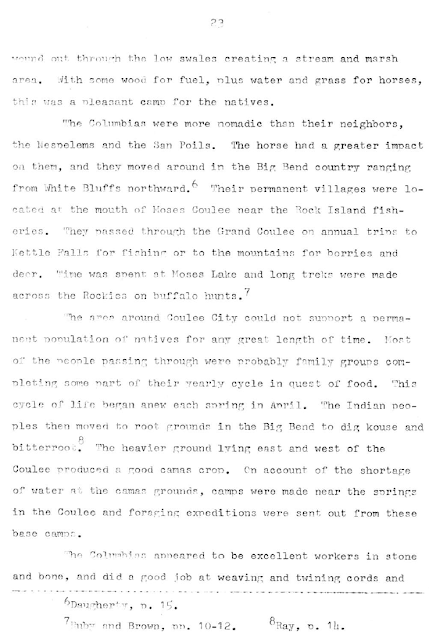________________________
________________________
21
CHAPTER III
PEOPLE IN THE BIG BEND COUNTRY
Native People
Evidence has been found that man lived in the Columbia Basin from 6,000 to 11,000 years ago. A site near Lind, Washington, was tested in the summer of 1950 and excavated in 1951-1952 by archaeologists from Washington State University. Their findings confirmed the belief that human occupation of a camp was in existence as early as 10,000 years ago at Lind Coulee. 1
The Columbia River, during its torrential run through the region, eroded caves in the basalt cliffs that formed the Coulee walls. Washington State University archaeologists have conducted a number of digs in these caves and found evidence showing that primitive man lived in the area around Coulee City as long as 8,000 years ago. 2 Primitive peoples, and more recently Indian groups had used these rock shelters as transitory home sites, storehouses, and burial places. Most of the caves were near springs or lakes. Near Coulee City are a number of artesian springs that were important camping grounds for Indian
____________
1 Daugherty, p. 51.
2 Roald Frysell and Richard D. Daugherty, "Late Glacial and Post Glacial Geological and Archaeological Chronology of the Columbia Plateau, Washington," An Interim Report to the National Science Foundation (n. p., 1963), p. 13.
________________________
22
peoples traveling through the region in their constant quest for food or on their way to fishing and trading fairs along the Columbia. The author and some of his friends have found Indian artifacts in large quantity within one mile of the city limits of Coulee City.
The Indian peoples who populated the region in more recent times were of the Interior Salishan stock and probably of the Columbia, Nespelem, or San Poil tribal communities. The San Poil and Nespelem had their permanent villages located at the mouth of the rivers that bear their names. 3 They may have come down the Coulee as far as Coulee City on their way to Soap Lake (the Great healing Water) or to trading and gambling fairs near Wenatchee. Alex Covington, a San Poil, told the author in the late 1950's that his wife's people had come to Coulee City to dig douse in the spring for as long as they could remember. 4 Ruby and Brown, in the book Half-Sun on the Columbia, state that Chief Moses' ansestors met with Spokane Indians to fire the plateaus towards the Grand Coulee to stampede and kill antelope. The Columbias had a well-used campground that they called Squaquint near Dry Falls. 5 The author believes that this is the campground that lies about one-half mile northwest of Coulee City. Big springs bubbled out of the ground and overflow
____________
3 Verne F. Ray, The San Poil and Nespelem: Salishan Peoples of Northeastern Washington (Seattle: University of Washington Press, 1933), pp. 6-13.
4 Interview with Alex Covington, April, 1957.
5 Robert H. Ruby and John A. Brown, Half-Sun on the Columbia (Norman: University of Oklahoma Press, 1965), pp. 9-10.
________________________
23
wound out through the low swales creating a stream and marsh area. With some wood for fuel, plus water and grass for horses, this was a pleasant camp for the natives.
The Columbias were more nomadic than their neighbors, the Nespelems and the San Poils. The horse had a greater impact on them, and they moved around in the Big Bend country ranging from White Bluffs northward. 6 Their permanent villages were located at the mouth of Moses Coulee near the Rock Island fisheries. The passed through the Grand Coulee on annual trips to kettle Falls for fishing or to the mountains for berries and deer. Time was spent at Moses Lake and long treks were made across the Rockies on buffalo hunts. 7
The area around Coulee City could not support a permanent population of natives for any great length of time. Most of the people passing through were probably family groups completing some part of their yearly cycle in quest of food. This cycle of life began anew each spring in April. The Indian peoples then moved to root grounds in the Big Bend to dig douse and bitterroot. 8 The heavier ground lying east and west of the Coulee produced a good camas crop. On account of the shortage of water at the camas grounds, camps were made near the springs in the Coulee and foraging expeditions were sent out from these base camps.
The Columbias appeared to be excellent workers in stone and bone, and did a good job at weaving and twining cords and
____________
6 Daugherty, p. 15.
7 Ruby and Brown, pp. 10-12.
8 Ray, p. 14.
________________________
24
________________________
25-26
 |
This is a view of Coulee City taken from the monocline on the west wall of the Grand Coulee. |
________________________
27
fabric of sagebrush bark and other plants. 9 Artifacts found near Coulee City are made of chalcedony, chert, and petrified wood. There are also bone, basaltic, and quartzite scrapers. The quartzite scrapers are reported by Ray to be a tool used by the San Poils. 10
Life was not easy for these native peoples and as a result, their social structure was simple and, in most cases, they managed to stay out of conflicts with the white man as he came into the region in the 1800's. Like other native peoples across the land they picked up the white man's vices and diseases. Ray mentions a smallpox epidemic decimating the San Poil and Nespelem peoples in 1846 and 1852-53. Measles took a toll among these same tribes in 1847. 11
____________
9 Douglas Osborne, "Archaeological Tests in the Lower Grand Coulee, Washington." Unpublished Xerox report of excavations conducted by Washington State College and the State Department of Conservation and Development (n.p., 1960), pp. 14-16.
10 Ray, P. 234.
11 Ibid., pp. 21-22.
________________________
________________________
________________________
________________________
________________________
(page 24 is fig. 6, above)
(pages 25-6 are fig. 7, above)
________________________
________________________






No comments:
Post a Comment